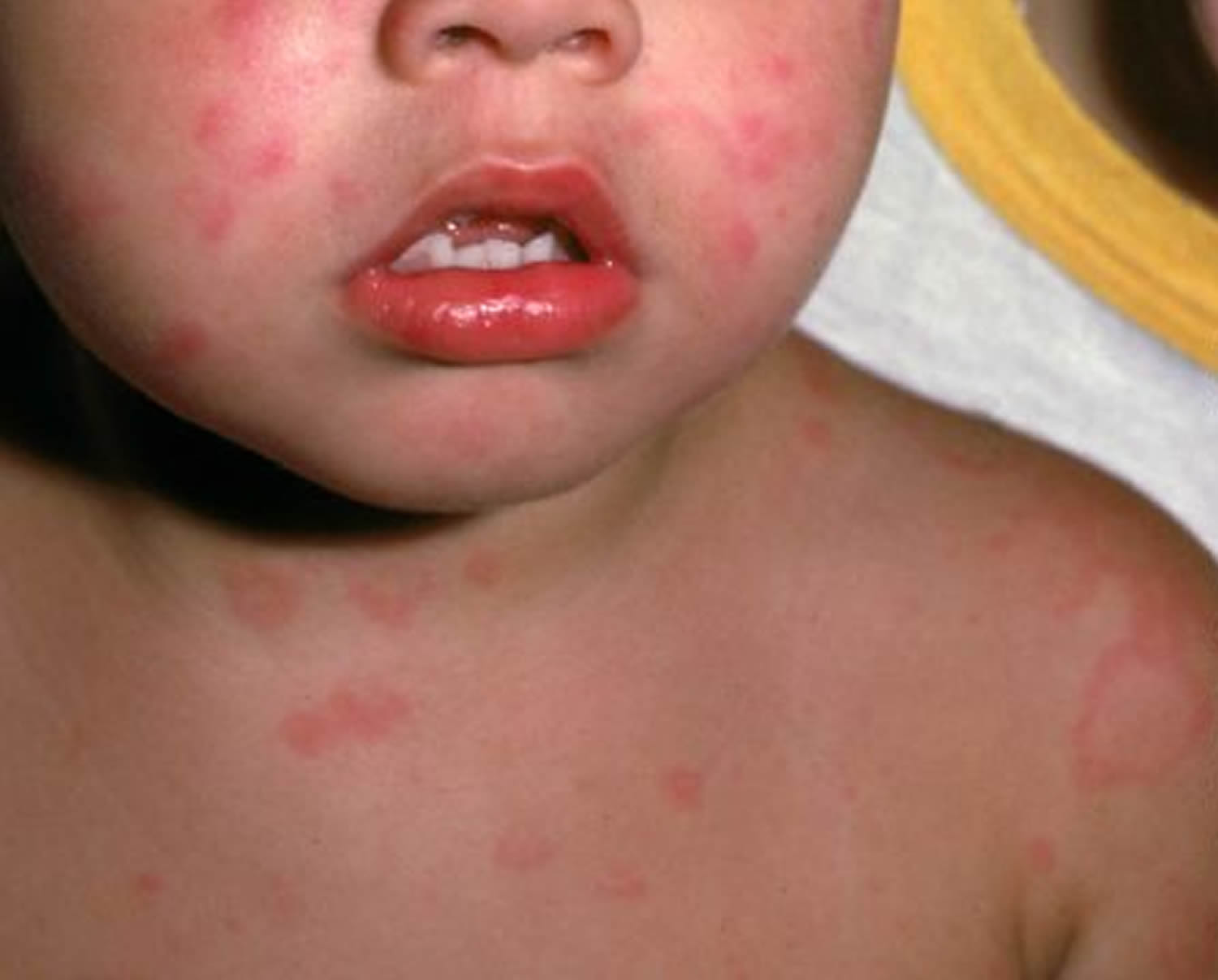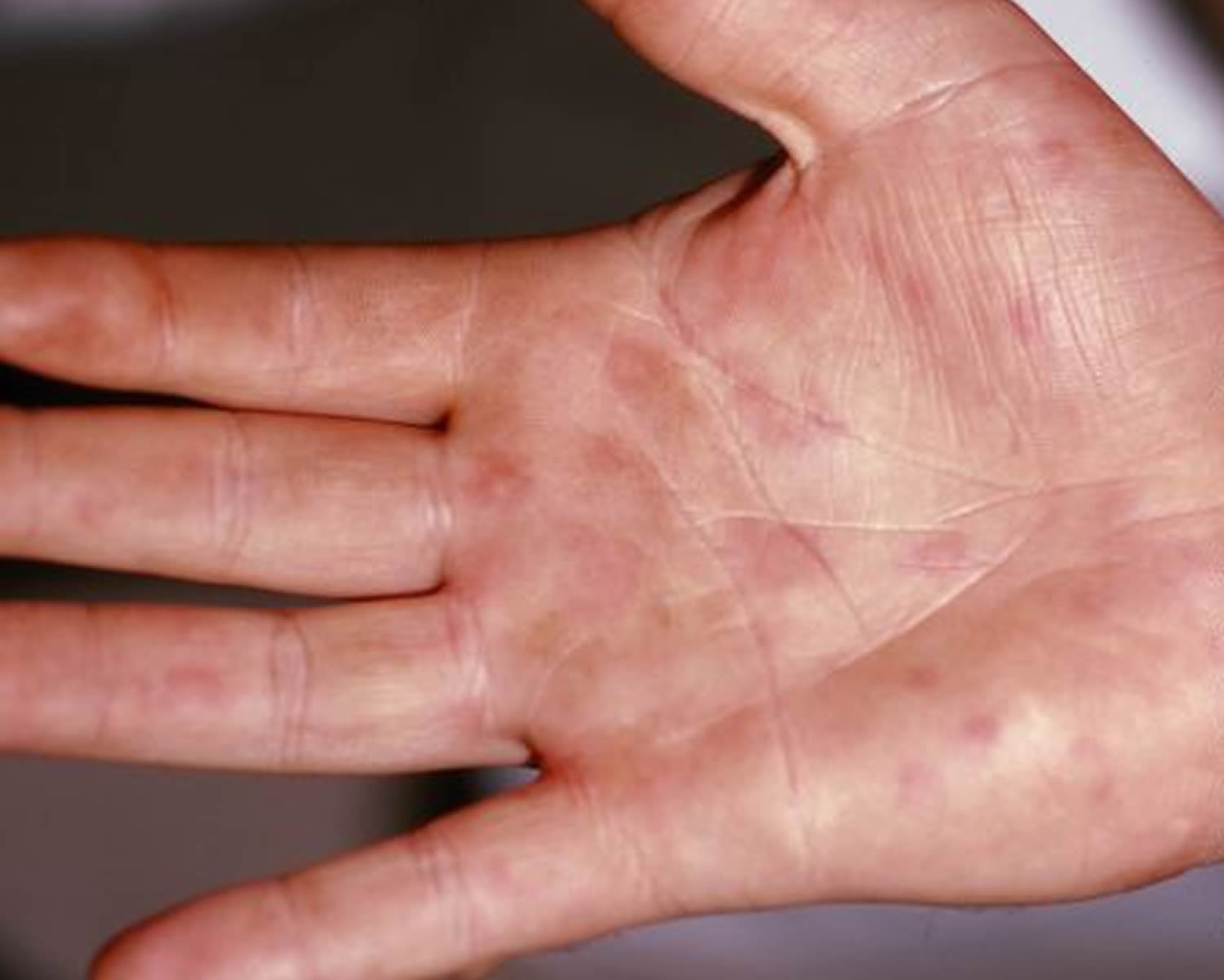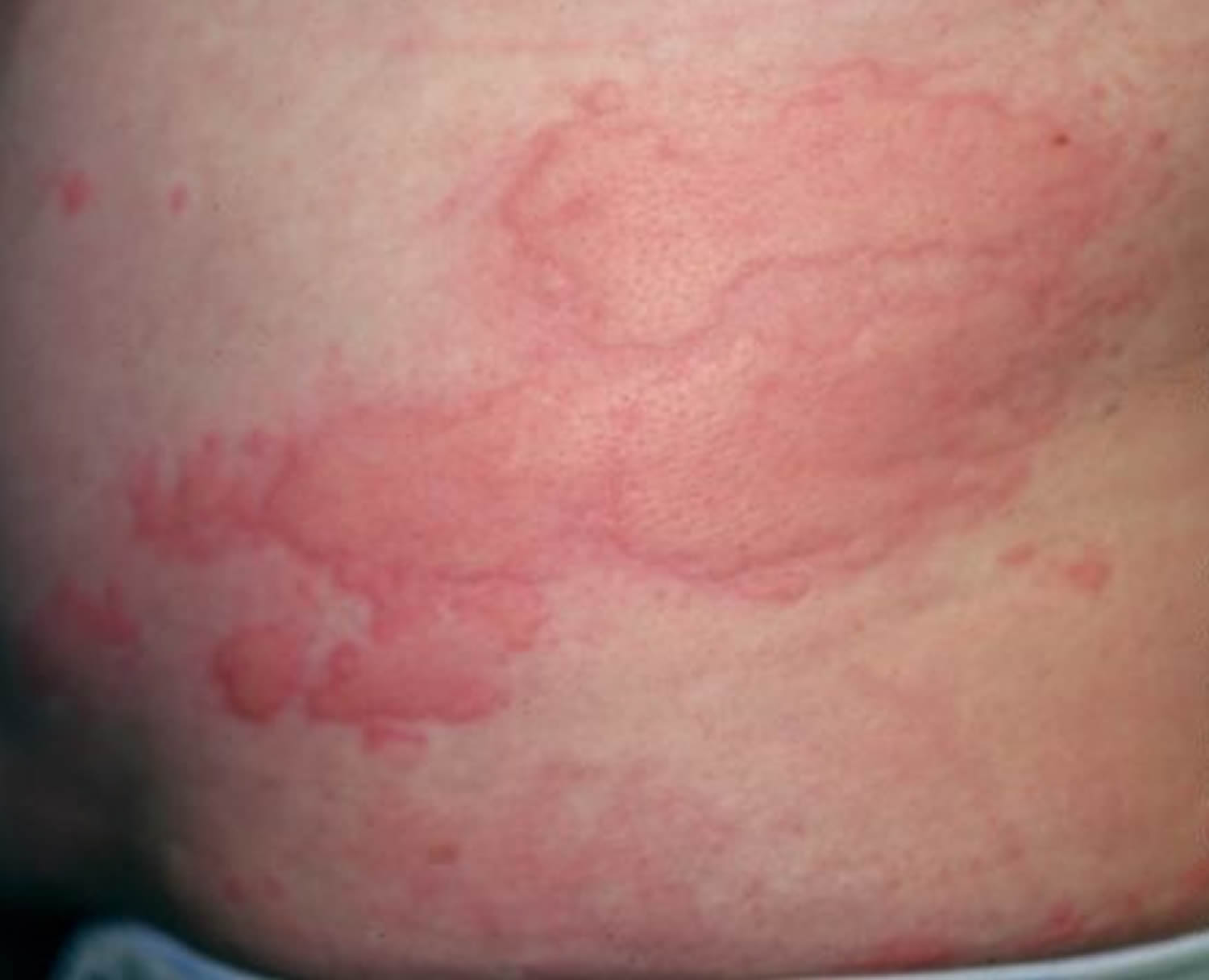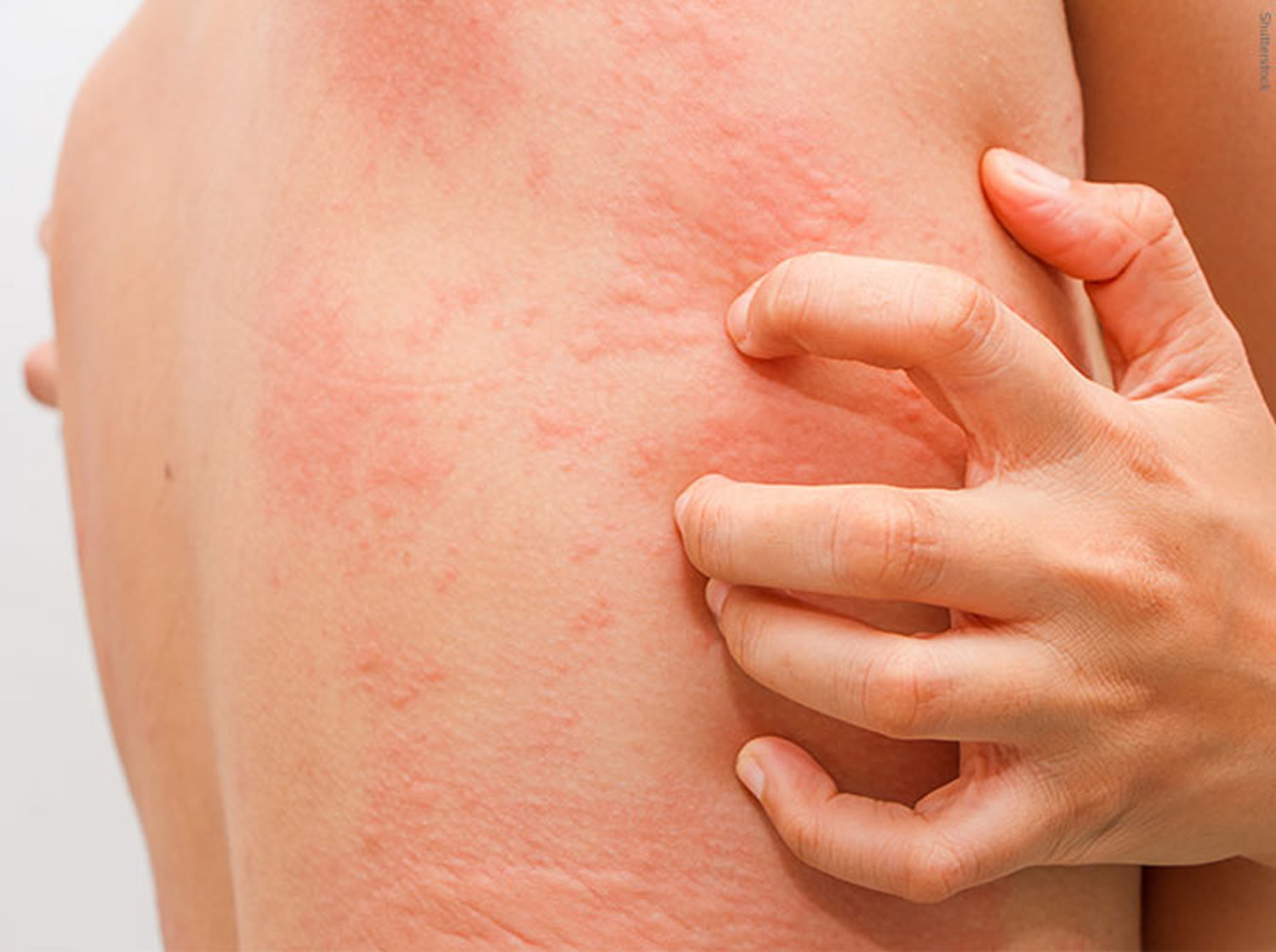Contents
What is urticaria
Urticaria also called hives, is a skin reaction usually caused by allergy or from stress, characterized by swelling, bumps, itching and burning that appear and disappear anywhere on the body 1. The important symptom of urticaria is itch (pruritus). Urticaria or hives are sometimes referred to as welts or wheals surrounded by a red halo or flare (area of erythema). An individual lesion of hives typically appear over the course of minutes, enlarge, and then disappear within hours and new hives can appear as older areas disappear. Individual wheals rarely last more than 12hrs. The surrounding erythema (redness) will blanch with pressure.
Urticaria is a common condition that you can get at any age. Urticaria can occur anywhere on your body in a variety of shapes and sizes. Urticaria may be acute or chronic
- Acute = new onset urticaria < 6 weeks
- Chronic = recurrent urticaria (most days) > 6 weeks
Most urticaria is acute and resolves.
Urticaria is caused by swelling of the upper dermis. Up to 20% of the population experience urticaria at some point in their lives. Urticaria differ from a similar condition called angioedema, which is swelling under skin. Angioedema can be caused by the same pathogenic mechanisms as urticaria, but the pathology is in the deep dermis and subcutaneous tissue and swelling is the major manifestation. Angioedema may be painful or burning, but usually not pruritic (non itchy). You can have these conditions at the same time or separate.
Doctors arbitrarily divide urticaria into acute (new or periodic episodes lasting fewer than 6 weeks) and chronic (periodic episodes lasting more than 6 weeks). Though many people have a single episode of acute urticaria that goes away within a few days to weeks, some individuals may have chronic urticaria, periodic (recurrent) attacks of urticaria that come over periods of years.
Figure 1. Urticaria

Figure 2. Urticaria (widespread)

Figure 3. Urticaria (on face)

Figure 4. Urticaria (palm)

Figure 5. Urticaria

Note: This image displays welts and large hair follicle openings caused by swelling from urticaria (hives).
Symptoms of urticaria
The most common locations for urticaria include:
- Trunk
- Upper arms or upper legs
However, urticaria can affect any skin surface.
Common symptoms are itching, redness, and swelling. Symptoms can appear right after an allergic exposure or later on, and can occur in any order.
Individual lesions of hives appear as distinct (well-defined), pink-to-red swellings ranging in size from 2 mm to over 30 cm, also are known as welts or wheals. Some lesions may develop a lighter center. The bumps have clear edges and can blend to create patches of raised skin. Hives usually appear in groups or batches.
You can get urticaria in a small, focused spot or in a large area. Another sign of urticaria is if you press the red bump and the middle part turns white (known as blanching).
Individual lesions of hives disappear within 24 hours, though a single episode may last much longer.
Dermographism is a type of urticaria that appears within a few minutes of scratching the skin. The rash usually appears in a straight line (linear) pattern.
Swelling of the eyes, mouth, hands, feet, or genitals can sometimes occur with hives. This swelling, called angioedema, usually goes away within 24 hours.
Hives is usually an itchy rash that can also burn or sting.
What causes urticaria ?
Most people get urticaria from an allergic reaction. Your body responds to allergies by releasing chemicals into your blood. These chemicals, such as histamine, trigger the bumps and swelling known as hives.
In up to 90% of outbreaks of hives, a trigger is never found despite extensive testing; these cases are referred to as idiopathic urticaria. In approximately 50% of idiopathic urticaria outbreaks, hives are most likely caused by a reaction from the person’s own immune system (autoimmune reaction).
Common allergies that produce hives include:
- Pollen
- Poisonous plants
- Insect bites
- Medicines, especially aspirin, ibuprofen, naproxen, narcotic painkillers, or antibiotics
- Various foods and preservatives
- Food allergies, such as strawberries, fruits, eggs, nuts or shellfish
- Animal dander
- Stress
- Materials, like wool or latex
- IV administration of blood products, contrast agents.
You also can get hives from:
- Hay fever
- Stress
- Infection or illness with viruses, bacteria, or fungi. Upper respiratory, streptococcal infections and helminths (parasitic worms). Most common cause of urticaria in children is viral illness. Infections such as mononucleosis.
- Sweating too much
- Tiredness
- Tight clothing
- Quick change in body temperature
- Extreme weather, such as too cold or too hot.
- Physical exposures such as heat, cold, water, sunlight, or pressure
- A medical condition such as gland diseases, blood diseases, or cancer (leukemia)
- Illness, including lupus and other autoimmune diseases
Often, the cause of hives is not known.
Vasculitis is a rare condition where your blood vessels inflame. It can cause hives that are more painful.
Who’s at risk of urticaria ?
Urticaria or hives can appear in people of all ages, of all races, and of both sexes.
Acute urticaria are most common in children and young adults, and chronic hives are more often seen in females, especially middle-aged women.
Urticaria are very common; it is estimated that up to 20% of the population may develop hives at some point in their lives.
What is physical urticaria ?
Urticaria due to physical causes, such as pressure, cold, or sun exposure, are called physical urticaria.
Many patients with chronic urticaria have physical factors that contribute to their urticaria
- These factors include pressure, cold, heat, water (aquagenic), sunlight (solar), vibration, and exercise
- Cholinergic urticaria is triggered by heat and emotion
- The diagnosis of pure physical urticaria is made when the sole cause of a patient’s urticaria is a physical factor.
It can be hard to figure out what causes chronic urticaria, though it’s sometimes linked to an immune system illness, like lupus. Other times, medications, food, insects, or an infection can trigger an outbreak. Often, though, doctors don’t know what causes chronic hives.
How are urticaria diagnosed ?
Your doctor can diagnose urticaria by looking at your skin. They also might want to perform blood, skin, or urine tests, such as a skin-prick test or biopsy. These tests can confirm if you had an allergic reaction and what caused it. However, sometimes the cause of urticaria is unknown.
Can urticaria be prevented or avoided ?
Urticaria cannot always be prevented. You might not know you are allergic to something, or you met get hives from unplanned stress or elements.
You can help reduce the chance of getting hives if you:
- Avoid food or substances that you (know you) are allergic to.
- Avoid wearing tight clothing for long periods of time.
- Monitor your stress levels.
- Wash your hands regularly.
- Avoid too much sun contact.
- Regulate extreme body and weather temperatures.
- Avoid too much sun contact.
Urticaria treatment
Most cases of urticaria go away on their own. However, there are things you can do to lessen the effects (itchiness and swelling), such as:
- Avoid scratching the itchy area.
- Take a cool bath or shower (or a hot bath or shower, in cases of cold-induced hives).
- Use a cold cloth or pad.
- Apply an anti-itch cream.
- Wear loose clothing.
- Take an antihistamine, such as Benadryl, to counter the histamine (chemical allergic reaction).
- Avoid alcohol, tobacco, and exercise.
You might need extra treatment if you have a severe case of urticaria or if the bumps occur in a sensitive area, like the throat, lips, or eyes. Your doctor can give you a shot of epinephrine (adrenaline) or steroids.
The best treatment for urticaria is to discover any triggers and stop your child’s exposure to them. However, most people with urticaria do not know the cause, and they require medications to get rid of the urticaria.
The most common medications for urticaria include 2:
- Sleep-causing (sedating) type-1 antihistamines such as diphenhydramine, hydroxyzine, or cetirizine
- Non-sleep-causing (non-sedating) type-1 antihistamines such as loratadine, fexofenadine, or desloratadine
- Type-2 antihistamines such as anitidine, cimetidine, or famotidine
- Doxepin
- Montelukast, zafirlukast, or zileuton
In rare situations, the doctor might prescribe a short course of oral corticosteroid pills.
Urticaria home remedies
If your child is experiencing mild urticaria, you might have him or her:
- Take cool showers
- Apply cool compresses
- Wear loose-fitting clothes
- Avoid strenuous activity
- Use an over-the-counter antihistamine such as diphenhydramine or loratadine
In addition, try to discover and avoid any triggers of your child’s hives.
When to Seek Medical Care
If your child’s urticaria make it difficult to breathe or swallow or if your child feels lightheaded, call your local emergency number.
In other, non-urgent, situations, see your child’s doctor if the urticaria do not improve with treatment or if they continue to appear for more than a few days.
Before visiting your doctor, try to notice what might be triggering your child’s hives and whether it improves or worsens with exposure to heat, cold, pressure, or vibration. Take a list of every medication (prescription or over-the-counter), supplement, or herbal remedy your child may have taken recently. Also, recall any recent illnesses your child might have had, since some illnesses (or their treatments) can trigger hives.
Living with urticaria
Urticaria typically last for a short time and go away on their own. It is uncommon for urticaria to leave bruising or scars. Contact your doctor if your urticaria last for more than 6 weeks. You might have chronic urticaria and need to see an allergy or dermatology (skin) doctor to manage the condition. He or she may ask you to keep a diary of foods and substances that you’ve been exposed to. This will help determine what you could be allergic to.
Urticaria typically are harmless, but there are some risks. If your whole body reacts, you might have other problems, like anaphylaxis. This causes swelling in your throat and breathing problems that can be life threatening.
Call your local emergency number or go to the emergency room if you experience:
- shortness of breath or difficulty getting air in your lungs
- swelling in your tongue, throat, or face
- fainting.





